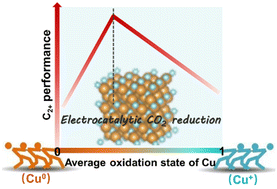Identifying the optimal oxidation state of Cu for electrocatalytic reduction of CO2 to C2+ products†
Abstract
The electrocatalytic CO2 reduction reaction (CO2RR) to C2+ products is of great importance. It is known that the co-operation of Cu1+ and Cu0 in the catalysts can yield a high faradaic efficiency (FE). However, it is very difficult to figure out the optimal ratio of Cu1+ and Cu0 because Cu1+ can be reduced to Cu0 during CO2RR. To solve this problem and identify the optimal oxidation state of Cu, herein we propose a strategy to prepare Cu catalysts with different oxidation states, which could be stabilized by the pulsed electrolysis method during CO2RR. On the basis of this method, we have studied the effect of the oxidation state of Cu on CO2RR to form C2+ products. It has been found that the Cu catalyst with an oxidation state of +0.41 is the most efficient in our reaction system, and the FE of C2+ products is 70.3% in an H-type cell. This work provides a precise method to identify the optimal oxidation state of the catalysts that are not stable in the reaction.

- This article is part of the themed collection: Advances in Electrosynthesis for a Greener Chemical Industry


 Please wait while we load your content...
Please wait while we load your content...